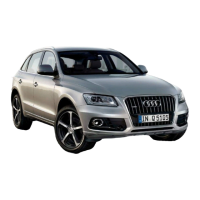
Do you have a question about the Audi Q5 2014 and is the answer not in the manual?
| Brand | Audi |
|---|---|
| Model | Q5 2014 |
| Category | Automobile |
| Language | English |
Mechanism to open the hood.
Button for accessing the luggage compartment.
Controls for operating the vehicle's windows.
Controls for adjusting the exterior mirrors.
Buttons to store and recall seat positions.
Switch to lock or unlock all doors centrally.
System that assists the driver with lane changes.
Controls for vehicle lights and dashboard illumination.
Port for vehicle diagnostics and data access.
Systems for maintaining vehicle speed automatically.
Controls for turn signals and high beam headlights.
Buttons for manual gear shifting control.
Buttons on the steering wheel for various functions.
Dashboard gauges and warning light indicators.
Controls for windshield wipers and trip computer data.
Mechanism for starting and stopping the vehicle's ignition.
The central screen for infotainment and vehicle settings.
How to activate hazard warning lights.
Indicator light for passenger airbag status.
Controls for the audio and multimedia system.
System for selecting different driving modes.
Systems for engine stop/start and electric driving.
Features related to the vehicle's parking assistance.
System to maintain vehicle stability.
System to control vehicle speed on descents.
System for managing cabin temperature and air.
Control lever for selecting transmission gears.
Central unit for operating the MMI system.
Button to start and stop the engine.
Control for the electronic parking brake.
Mechanism to adjust the steering wheel's position.
Systems that provide assistance to the driver.
Procedure for connecting a mobile phone via Bluetooth.
Keyless entry and start system for the vehicle.
Procedures for securing and accessing the vehicle.
Instructions for initiating and terminating engine operation.
Description of the available gear selector positions.
Process for releasing the selector lock and engaging gears.
Manual gear shifting using the selector lever.
Steps for stopping the engine via the Start-Stop system.
Steps for starting the engine via the Start-Stop system.
How to open and close the fuel filler door.
Guidance on recommended fuel types for the vehicle.
Information on approved engine oil standards.
Details on correct tire pressures for the vehicle.
System for monitoring and resetting tire pressure alerts.
Explanation of the vehicle's power meter display.
How the vehicle operates in electric-only mode.
Procedures for turning electric-only mode on and off.
Icons in the instrument cluster indicating EV mode status.
Using the gasoline engine for propulsion.
Utilizing both engines for maximum acceleration.
Propulsion solely by the electric motor.
Advanced features for electric-only driving.
Coasting without using the engine or brakes.
Regenerating energy during braking or coasting.
Automatic engine start based on driving conditions.
Efficient procedures for starting from a standstill.
Techniques for steady speed and efficient coasting.
Tips for economical driving in urban environments.
Tips for economical driving on highways.
Overview of the main parts of the MMI/Radio system.
Controls on the steering wheel for the MMI system.
The central display for radio and MMI functions.
How to switch the MMI system on and off.
Buttons for quick access to main menu functions.
Using the knob for selection and confirmation.
Buttons that activate functions shown in MMI display corners.
Button for canceling selections or returning to previous functions.
Using the joystick for map navigation and menus.
Instructions for dialing numbers and accessing call lists.
Procedure for finding and calling contacts from the directory.
Instructions for setting the time manually or via GPS.
Using voice commands to operate MMI functions.
Steps to enhance voice command accuracy.
Examples of commands for various functions.
Steps to begin the navigation process.
Procedure for inputting destination addresses.
Procedure for inputting city or ZIP code.
Selecting letters to find destination names.
Initiating the calculation and display of a route.
Indicator for the dynamic steering system.
Indicator for the tire pressure monitoring system.
Indicator for diesel engine glow plug status.
Indicator for trailer turn signal function.
Indicator for the ESC system status.
General indicator for vehicle malfunctions.
Indicators for safety systems, specific to the USA market.
Indicator for adaptive cruise control system.
Indicator for adaptive cruise control in traffic.
Indicator for active high beam headlights.
Indicator when cruise control is active.
Indicator for the ABS system status.
Indicator for the parking brake status.
Indicator for low engine oil level.
Indicator for low AdBlue fluid level.
Indicator for a malfunction in the AdBlue system.
Indicator for a problem with the steering system.
Indicator for a problem with the ignition lock.
Indicator for the hybrid drive system status.